|
|
 |
Barnaba Da Modena
|
|
active in Genoa and Pisa 1361-1383
was an Italian painter of the mid-14th century Lombardy. There is a painting by him in the church of San Francesco in Alba. A Virgin and Child once in Frankfort, was painted in a Byzantine style and is currently located at the Museum of Fine Arts in Boston, |
|
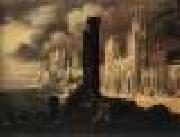 |
BARRA, Didier
|
|
French painter (b. 1590, Metz, d. 1644, Napoli
French painter, active in Italy. He was for a long time confused with FRAN?OIS DE NOM?, and the work of both artists was thought to be by a Mons? Desiderio, a 'highly praised painter of perspectives and city scenes' (de Dominici). It is now generally accepted that Mons? Desiderio was the pseudonym of Didier Barra (1982 exh. cat.), son of Cl?ment Barra. Didier Barra left Metz probably c. 1608, when his name appeared for the last time in the city archives. From c. 1630 he was active in Naples, where he came into contact with landscape and townscape painters from northern Europe. De Dominici wrote that he was associated with Belisario Corenzio. The point of departure in reconstructing Barra's oeuvre is the Panoramic View of Naples (Naples, Mus. N. S Martino), which is signed and dated Desiderius Barra ex civitate Methensi in Lotharingia, F. 1647. The picture is a precise and panoramic view of Naples from the sea, from a single viewpoint, enriched by lively brushwork and with spirited scenes of shipping in the foreground. Its topographical precision suggests that Barra was influenced by the engravings of large views of Naples made by Alessandro Baratta ( fl 1629-30), and he may himself have trained as a cartographer. On the basis of this picture, several views of Naples have been attributed to Barra. |
|
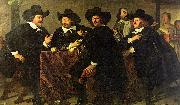 |
Bartholomeus van der Helst
|
|
1613-1670
Dutch
Bartholomeus Van Der Helst Galleries
Dutch painter. He was the son of a Haarlem inn-keeper and presumably undertook part or all of his training in Amsterdam. His earliest works suggest that the painter Nicolaes Eliasz. Pickenoy was his master. Although van der Helst had probably already established himself as an independent master by the time he married Anna du Pire in Amsterdam in 1636, his earliest known work, a portrait of The Regents of the Walloon Orphanage, Amsterdam (Amsterdam, Maison Descartes), dates from 1637. Stylistically it is close to the work of Pickenoy. His portrait of a Protestant Minister of 1638 (Rotterdam, Boymans-van Beuningen) reveals the influence of Rembrandt. The young artist must have risen rapidly to fame in Amsterdam, for as early as 1639 he received the prestigious commission for a large painting for the Kloveniersdoelen (Arquebusiers or Musketeers Hall): The Civic Guard Company of Capt. Roelof Bicker and Lt Jan Michielsz. Blaeuw (Amsterdam, Rijksmus.), which formed part of the same series as Rembrandt Night Watch (Amsterdam, Rijksmus.). Van der Helst may not have completed this commission until 1642 or 1643. The ingenious arrangement of the figures in a broad composition shows the artist special talent for composing large groups. Pickenoy influence is less noticeable here than in the portrait of 1637; the self-assured poses of the individual figures were to become a characteristic feature of van der Helst work. The successful execution of this portrait established van der Helst reputation: from 1642, when he began to receive an increasing number of commissions for individual portraits, until 1670 he was the leading portrait painter of the ruling class in Amsterdam. From 1642 his technique in portrait painting gradually became more fluent and the rendering of costume materials more detailed. Some typical portraits of his earlier period are those of Andries Bicker (Amsterdam, Rijksmus.), his wife Catharina Gansneb Tengnagel (Dresden, Gemeldegal. Alte Meister) and their son Gerard Bicker (Amsterdam, Rijksmus.), all of 1642, and the Portrait of a Young Girl (1645; London, N.G.). In 1648 van der Helst painted a second civic guard portrait, The Celebration of the Peace of M?nster at the Crossbowmen Headquarters, Amsterdam (Amsterdam, Rijksmus.), a superbly composed and well painted portrait that, until the late 19th century, was considered one of the masterpieces of the Golden Age but later lost popularity because of its smooth and modish execution. It can nevertheless still be regarded as one of the most important group portraits of the 17th century. Its technical perfection, characterized by a well-modelled rendering of the figures and a smooth handling of the brush, dominated the rest of van der Helst oeuvre. |
|
 |
Bartolo di Fredi
|
|
Italian Gothic Era Painter, ca.1330-1410
He had a large studio and was one of the most influential painters working in Siena and the surrounding towns in the second half of the fourteenth century. He registered in the Guild of that city in 1355; he had several children, who all died before him, with the exception of Andrea Bartoli. He was the companion of Andrea Vanni from 1353, and helped decorate the Hall of Council at Siena, in 1361. In 1362 he went to San Gimignano, where, by 1356, he had painted the entire side of the left aisle of the Pieve with scenes drawn from the Old Testament. In 1366 the Council of the city of Gimignano ordered a painting, representing Two Monks of the Augustine Order to be placed in the Palazzo Pubblico, in order to commemorate the settlement of some disputes which had long existed between that order and the city. In the early part of 1367 he returned to Siena, and was employed with Giacomo di Mino in the decorations of the cathedral. In 1372 he rose to a position in the government of the city, and was sent to welcome the new Podesta, on his approach to Siena. In 1381 he was himself made a member of the Council, and in 1382 he executed the Descent from the Cross now in the Sacristy of San Francesco, Montalcino. The same church also possesses panels painted by him containing the Baptism of Christ figures of SS. Peter, Paul, and Francis, and five scenes from the life of St. Philip of Montalcino. In 1389, Bartolo, assisted by Luca Thome, painted the altar-piece for the Shoemakers Company, in the Cathedral, and continued from that year until his death to furnish altar-pieces for the cathedral and other churches of Siena, which have now all disappeared.
His style is marked by the rejection of the concrete figures associated with Pietro Lorenzetti to instead favor flatter decorative otherworldly compositions in the manner of Simone Martini and Duccio. He combined a spirit of fantasy with anecdotal details.
The Honolulu Academy of Arts, the Los Angeles County Museum of Art, the Louvre, the Metropolitan Museum of Art, the Mus??e des Beaux-Arts (Chambery, France), the Musee du Petit Palais (Avignon, France), Museo Civico e Diocesano d Arte Sacra (Montalcinothe, Italy), the Museum of Fine Arts, Boston and the University of Virginia Art Museum are among the public collections having paintings by Bartolo di Fredi. |
|
 |
bartolomeo della gatta
|
|
(1448 -1502), born Pietro di Antonio Dei, was an Italian (Florentine) painter, illuminator, and architect. He was the son of a goldsmith. He was a colleague of Fra Bartolommeo. In 1468, Bartolomeo became a monk in the Order of Camaldoli, probably in the Church of Santa Maria degli Angeli in Florence, which his brother Nicolo had already entered. Upon taking holy orders, he changed his name to Bartolomeo. About 1481, he was summoned to Rome where he contributed to the cycle of frescos on the walls of the Sistine Chapel. Bartolomeo eventually became Abbot of San Clemente in Arezzo. He died in 1502 and was buried in the Abbey of San Clemente.
|
|
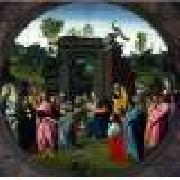 |
BARTOLOMEO DI GIOVANNI
|
|
Italian Early Renaissance Painter, active 1475-1511
Bartolomeo di Giovanni, also known as Bartolommeo di Giovanni and as Alunno di Domenico, was an early renaissance Italian painter of the Florentine School who was active from about 1480 until his death in 1501. He studied with and assisted Domenico Ghirlandaio, painting the predella of Ghirlandaio's Adoration of the Magi in the Ospedale degli Innocenti (Foundling Hospital) in Florence, in 1488. Bartolomeo di Giovanni also worked under the guidance of Sandro Botticelli. |
|
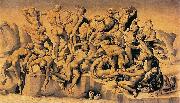 |
Bastiano da Sangallo
|
|
(1481 - May 31, 1551) was an Italian sculptor and painter of the Renaissance period, active mainly in Tuscany. He was a nephew of Giuliano da Sangallo and Antonio da Sangallo the Elder. He is usually known as Aristotile, a nickname he received from his air of sententious gravity. He was at first a pupil of Perugino, but afterwards became a follower of Michelangelo. Mentioned by Vasari as one who made a small copy of the Cartoon of Michelangelo Battle of Cascina (1506).
|
|
 |
BECCAFUMI, Domenico
|
|
Italian Mannerist Painter, ca.1486-1551
Domenico was born in Montaperti, near Siena, the son of Giacomo di Pace, a peasant who worked on the estate of Lorenzo Beccafumi. Seeing his talent for drawing, Lorenzo adopted him, and commended him to learn painting from Mechero, a lesser Sienese artist.[1] In 1509 he traveled to Rome, but soon returned to Siena, and while the Roman forays of two Sienese artists of roughly his generation (Il Sodoma and Peruzzi) had imbued them with elements of the Umbrian-Florentine Classical style, Beccafumi's style remains, in striking ways, provincial. In Siena, he painted religious pieces for churches and of mythological decorations for private patrons, only mildly influenced by the gestured Mannerist trends dominating the neighboring Florentine school. There are medieval eccentricities, sometimes phantasmagoric, superfluous emotional detail and a misty non-linear, often jagged quality to his drawings, with primal tonality to his coloration that separates him from the classic Roman masters. |
|
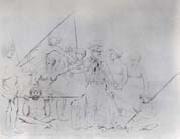 |
Benjamin Duterrau
|
|
1767 - 1851 , was an artist in England and in early colonial Australia. Duterrau was was born in London to parents of French descent. Duterrau was apprenticed to an engraver and in 1790 did two coloured stipple engravings after Morland, The Farmer's Door and The Squire's Door. Taking up painting, between 1817 and 1823 he exhibited six portraits at Royal Academy exhibitions, and he also exhibited three genre pieces at the British Institution about the same period. Duterrau emigrated to Van Diemen's Land (now Tasmania), arriving in August 1832 with his daughter. He lived at the corner of Campbell and Patrick Streets in Hobart, and practised as a portrait painter. In 1835 he did some etchings of Indigenous Australians, the first examples of that craft to be done in Australia. His most famous painting The Conciliation is in the Hobart gallery with a self-portrait and other works, including some modelling in relief. A large landscape is in the Beattie collection at Launceston, and he is also represented in the Dixson collection at Sydney. Duterrau died at Hobart in 1851. |
|
|
|
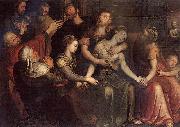 |
Bernaert de Ryckere
|
|
Bernaert de Rijckere (c1535, Kortrijk - 1590, Antwerp), was a Flemish Renaissance painter.
According to Karel van Mander he was born in Kortrijk and was admired there for an altarpiece depicting Christ bearing the cross, which he made for the St. Marten's church of the brothers of the Cross there. He later took on a different style that Karel van Mander had heard of but had not seen to be able to judge it for himself. He said he moved to Antwerp and joined the Guild of St. Luke there in 1561.
According to the Netherlands Institute for Art History he was the teacher of his son, the painter Abraham de Rijcke, and is known for landscapes and historical allegories. |
|
 |
Bernardo Daddi
|
|
active in Florence 1320-1348
was an early Italian renaissance painter and apprentice of Giotto. He was also influenced by the Sienese art of Lorenzetti. Daddi's birth date remains unknown. He is first mentioned in 1312. He focused on religious motifs and altarpieces. A triptych he painted in 1328 is in the Uffizi, and there are several panels in National Gallery of Art and the Walters Art Gallery. Daddi became the leading painter of Florence during his generation. His last work dates from 1347, |
|
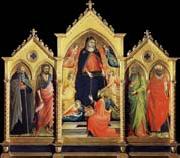 |
Bicci di Lorenzo
|
|
Italian, 1373-1452,was an Italian painter and sculptor, active in Florence. He was born in Florence in 1373, the son of the painter, Lorenzo di Bicci, whose workshop he joined. He married in 1418, and in 1424 was registered in the Guild of Painters at Florence. His son, Neri di Bicci was also a painter and took over the family workshop. Bicci di Lorenzo died in Florence in 1452 and was buried in Santa Maria del Carmine. Following early work - largely frescoes - in collaboration with his father, he received a number of important commissions, including, according to Vasari, from the Medici for a cycle of frescoes of Illustrious Men for the Palazzo Medici. For the Opera del Duomo, he painted frescoes of the apostles. And he painted a Saints Cosmas and Damian and frescoes representing the dedication of the church itself for Sant'Egidio in the hospital of Santa Maria Nuova. His best paintings are now thought to be the Madonna in Trono now in the National Gallery at Parma, the Three stories of St Nicholas triptych in the cathedral of Fiesole, and a Nativity in the church of San Giovannino dei Cavalieri in Florence. |
|
 |
Bicci Di Neri
|
|
(1419-1491) was an Italian painter of the Renaissance. A prolific painter of mainly religious themes, he was active mainly in Florence and in the medium of tempera. His father was Bicci di Lorenzo. His grandfather, Lorenzo di Bicci was also a painter in Florence, a pupil of Spinello Aretino.
Neri di Bicci's main works include a St. John Gualbert Enthroned, with Ten Saints for the church of Santa Trinita, an Annunciation (1464) in the Florentine Academy, two altarpieces in the Diocesan Museum of San Miniato, a Madonna with Child Enthroned in the Pinacoteca Nazionale of Siena, and a Coronation of the Virgin (1472) in the abbey church at San Pietro a Ruoti (Bucine. He also painter numerous works in the area of Volterra.
His journals from the years 1453-1475, including the rates of remuneration for his work, are still preserved in the library of the Uffizi Gallery. They are known as Ricordanze.
|
|
 |
Bicci, Neri di
|
|
Italian Early Renaissance Painter, 1419-1491
was an Italian painter of the Renaissance. A prolific painter of mainly religious themes, he was active mainly in Florence and in the medium of tempera. His father was Bicci di Lorenzo (1373-1452). His grandfather, Lorenzo di Bicci (c. 1350-1427) was also a painter in Florence, a pupil of Spinello Aretino. He painted a St. Giovanni Gualberto enthroned, with ten Saints for the church of San Pancrazio. His journals from the years 1453-1475, |
|
|
|
 |
Blythe David Gilmour
|
|
American Painter, 1815-1865
He began his career as an itinerant portrait painter in the early 1840s and became one of the leading satirical artists in America by the beginning of the Civil War. Self-taught, from 1840 to 1850 he worked in East Liverpool, OH, and Uniontown, PA, and nearby towns and villages, painting rather stiff likenesses of the local gentry. He also carved a monumental polychrome wooden statue of Marie-Joseph, Marquis de Lafayette for the Uniontown courthouse and painted a landscape panorama of the Allegheny mountains, which he took on tour through Maryland, Pennsylvania and Ohio. |
|
|
|
|
|
|
|
|
|
|
|
 |
BRAY, Dirck
|
|
Dutch painter, Haarlem school (active 1651-1678) |
|
|
|
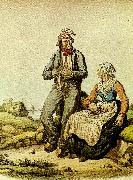 |
c. a. dahlstrom
|
|
Carl Petter Dahlström, född ca 1705, död 4 mars 1794, var en svensk möbelsnickare. Dahlström gesällvandrade 1745?C1755 i Nordeuropa och Frankrike, där han i Paris kom i lära hos den tidens främste ebenist Jean-François Oeben. Hos denne lärde sig Dahlström faneringstekniken marqueterie ?? fleurs eller blomsterintarsia, som var en metod för att möta rokokons krav på fanering av dubbelvälvda kroppar. Mycket tack vare rekommendationer av C.J. Cronstedt blev Dahlström efter hemkomsten till Sverige utnämnd till kunglig ebenist den 19 november 1756. Han finns representerad på Nationalmuseum med en byrå som han tillverkade tillsammans med Lorentz Nordin. Dahlström överlämnade 1769 sina privilegier till Niclas Palmgren och ägnade sig därefter åt restaurangverksamhet. |
|
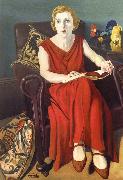 |
Cagnaccio di San Pietro
|
|
Italian, 1897-1946,born Natale Bentivoglio Scarpa, was an Italian magic realist painter. He had his artistic training at the Academy of Fine Art in Venice, where he studied under Ettore Tito. Cagnaccio's early paintings were in a Futurist idiom, but by the early 1920s he had adopted a very smoothly brushed, nearly photographic style. His work, which includes portraits, nudes, still lifes, scenes of popular life, and religious pictures, shows the influence of the German painters of the New Objectivity. One of his best-known paintings, After the Orgy (1928) shows three nude women asleep on a floor littered with wine bottles, playing cards and cigarettes. |
|
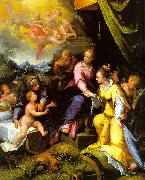 |
Calvaert, Denys
|
|
Flemish, 1540-1619
Flemish painter and draughtsman, active in Italy. In 1556-7 he was inscribed in the registers of the painters' corporation in Antwerp as a pupil of the landscape painter Kerstiaen van Queboorn (1515-78). Calvaert went to Bologna c. 1560, where he was to remain for the rest of his life. There he came under the protection of the influential Bolognini family and entered the workshop of Prospero Fontana the elder. After about two years he left Fontana to work with Lorenzo Sabatini, with whom he collaborated on several pictures, including the Holy Family with the Archangel St Michael (Bologna, S Giacomo Maggiore) and an Assumption (Bologna, Pin. N.). Calvaert's oeuvre is composed almost exclusively of religious works, ranging in size from vast altarpieces to small devotional pictures on copper. This sets him apart from other Netherlandish painters, notably those of the school of Prague, for whom Classical mythology was a constant source of inspiration. His first signed and dated work was Vigilance (1568; Bologna, Pin. N.); thereafter he developed a more original style, as in the Noli me tangere (Bologna, Pin. N.). |
|
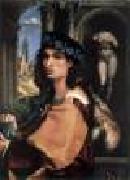 |
CAPRIOLO, Domenico
|
|
Italian painter, Venetian school (b. 1494, Venezia, d. 1528, Treviso)
Italian painter. He moved from Venice to Treviso c. 1517, where he is well documented (though there is little about his painting). In 1518-19 he married Camilla, daughter of the painter Pier Maria Pennacchi. A coherent body of work executed between 1518 and 1528 has been reconstructed. Capriolo's first secure work, the Adoration of the Shepherds (Treviso, Mus. Civ.), signed and dated 1518, has a formal structure reminiscent of the late style of Giovanni Bellini, with the broader chromatic range of Palma Vecchio and a crepuscular light that recalls the Venetian works of Giovanni Girolamo Savoldo or Giovanni da Asola ( fl 1512-31). The Assumption in Treviso Cathedral, commissioned in 1520, shows, in its spiralling movement, the influence of the contemporary frescoes of Pordenone in the nearby Malchiostro Chapel. In the Legend of the Doubting Midwife (Treviso, Mus. Civ.), signed and dated 1524, the influence of Savoldo is greater than that of Palma. This is also apparent in the altarpiece of the parish church of Ponzano Veneto (Treviso), dated 1525. The portrait of Lelio Torelli (Barnard Castle, Bowes Mus.), signed and dated 1528, Capriolo's last known work, seems by contrast to reflect local models of portraiture and lies somewhere between the styles of Sebastiano Florigerio and Bernardino Licinio. Other works assigned to Capriolo include: the altarpieces of the parish churches of Cavasagra and Spercenigo, near Treviso; the Adoration of the Shepherds in the sacristy of Serravalle Cathedral at Vittorio Veneto; a fragment of a Nativity (Venice, Mus. Correr); two paintings of the Virgin and Child with Saints (Bucharest, Mus. A.; Conegliano, Mus. Civ. Castello). |
|
 |
Carel de Moor
|
|
(February 25, 1655 - February 16, 1738) was a Dutch Golden Age etcher and painter. He was a pupil of Gerard Dou.
Carel de Moor was born in Leiden. According to Houbraken, his father was an art dealer who wanted him to study languages and only allowed him to study art when his talent for drawing surfaced at a young age. Houbraken met him in person at the atelier of Godfried Schalcken when he was completing his education there. According to the RKD he was the son of a Leiden painter of the same name and a pupil of Dou, Frans van Mieris, Godfried Schalcken, and Abraham van den Tempel. He became a member of the Leiden Guild of St. Luke in 1683, and became deacon many times over in the years 1688-1711. His own pupils later were Pieter Lyonet, Andrei Matveev, Arent Pijl, Arnout Rentinck, and Mattheus Verheyden.
|
|
|
|
 |
Carl d Unker
|
|
(3 February 1828 - 23 June 1866)was a Swedish artist. He was mostly known as a socially oriented genre painter whose works were contemporary subjects of his time, like waiting rooms at railway stations, and scenes from pawnshops for example.
D'Unkers father was a Norwegian military, his mother Swedish. He began his career as a military and had served at the Svea Life Guards for a short time, when he in 1848 volunteered in the First Schleswig War 1848-1849. Shortly after his return to Sweden he abandoned his military path and went to the arts. He moved to Desseldorf to study painting, there he got married to a wealthy Russian woman and could live a carefree life financially. He became a very popular artist on the continent. From 1861 he suffered from sickness in his right arm so he had to paint with his left arm. He made a brief visit to Sweden in 1865, and was appointed professor by Swedish king Charles XV. The following year he died. |
|
|
|
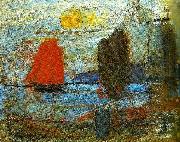 |
carl kylberg
|
|
Carl Oscar Kylberg, född 23 september 1878 på Vasängen i Fridene församling, död 6 januari 1952 i Stockholm, svensk konstnär och representant för Göteborgskoloristerna.
Carl Kylberg var son till kontorschef Gustaf Kylberg och friherrinnan Eleonora von Essen och storebror till konstnären Erik Kylberg. Hans fastrar och farbror var konstnärerna Regina Kylberg-Bobeck, Marina Kylberg och Hjalmar Kylberg. Farfadern Lars Wilhelm Kylberg var konstnär vid sidan av lantbruket på familjegodset Såtenäs i Västergötland.
Kylberg studerade först vid tekniska skolan i Stockholm och i Berlin för att bli arkitekt men övergick till måleri omkring 1900. Han studerade under en tid vid Valand i Göteborg som elev till Carl Wilhelmson. Hans verk kännetecknas ofta av ett glödande oljemåleri med starka färger och han avbildade ofta landskap och figurkompositioner på ett avskalat man??r. Under senare delen av sitt konstnärskap skapade han en mängd religiösa motiv.
Kring 1930-talet fick han sitt genombrott och han kom att ställa ut, förutom i Sverige även i Köpenhamn, Paris, London, Budapest och i USA men hans måleri var för många provocerande och 1938 gick regeringen in och stoppade ett köp av målningen Uppbrottet för Nationalmuseum i Stockholm.
En av hans mest välkända målningar är Hemkomsten från 1938 som hänger på Göteborgs konstmuseum och som föreställer ett skepp i silhuett mot en nästan brinnande gul himmel och ett rödfärgat hav. Denna målning förevigades också 1978 på ett svenskt frimärke av valören 90 öre.
Sedan 1980-talet har många av hans tavlor sålts för rekordpriser vid olika internationella konstauktioner.
|
|
 |
Carlo Dolci
|
|
1616-1686
Italian
Carlo Dolci Locations
Italian painter. The major Florentine painter of the 17th century, he enjoyed an international reputation in his own lifetime. He was a gifted portrait painter and painted a number of large altarpieces, but his reputation is largely based on his half-length, single-figure paintings, characterized by their intense religiosity and meticulous technique. His mature style was complex and sophisticated. Intended for cultivated and aristocratic circles, his was never a popular art in any sense. Baldinucci described the painter tormented fantasy and dark fantasms, and his disturbed personality is evident throughout his work after the later 1640s. |
|
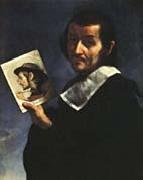 |
Carlo Dolci
|
|
Italian Baroque Era Painter, 1616-ca.1686
was an Italian painter of the Baroque period, active mainly in Florence, known for highly finished religious pictures, often repeated in many versions. He was born in Florence, on his mother's side the grandson of a painter. Although he was precocious and apprenticed at a young age to Jacopo Vignali, Dolci was not prolific. "He would take weeks over a single foot", according to his biographer Baldinucci. His painstaking technique made him unsuited for large-scale fresco painting. He painted chiefly sacred subjects, and his works are generally small in scale, although he made a few life-size pictures. He often repeated the same composition in several versions, and his daughter, Agnese Dolci, also made excellent copies of his works. Dolci was known for his piety. It is said that every year during Passion Week he painted a half-figure of the Saviour wearing the Crown of Thorns. In 1682, when he saw Giordano, nicknamed "fa presto" (quick worker), paint more in five hours than he could have completed in months, |
|
 |
Carlos de Haes
|
|
Spanish
1826-1898
Carlos de Haes Galleries
Spanish painter of Belgian birth. In 1835 he moved with his parents to M?laga, where he studied under the court portrait painter and miniature painter Luis de la Cruz y R?os (1776-1853). In 1850 he returned to Belgium and studied with the landscape painter Joseph Quineaux (1822-95). During his studies there and on his travels in France, Germany and Holland, he became acquainted with contemporary Realist trends. He returned to Spain in 1855, becoming a naturalized Spaniard, and the following year he exhibited numerous landscapes at the Exposici?n Nacional, Madrid, to much acclaim. In 1857 he won the competition for the fourth chair of landscape painting at the Escuela de Bellas Artes in Madrid with View of the Royal Palace from the Casa de Campo (1857; Madrid, Real Acad. S Fernando), a work showing characteristics of the Barbizon and Fontainebleau landscape schools. In 1860 he was elected Acad?mico de m?rito at the Real Academia de S Fernando in Madrid. By 1861 he was officiating and drawing up the regulations for the landscape competitions for aspiring pensionnaires. Consequently plein-air works came to be required in place of the previous tradition of submitting historical landscapes executed in the studio, a practice that discouraged the study of nature. De Haes suggested that only final corrections should be made in the studio, an attitude that indicates his timid initiation and acceptance of Realist trends. |
|
|
|
 |
Caspar David Friedrich
|
|
1774-1840 Caspar David Friedrich Locations German painter, studied art at Copenhagen, and in 1798 settled in Dresden. Friedrich painted chiefly landscapes and seascapes, with and without figures, architectural pictures, including a few of Dresden, and some religious subjects. Religious feeling and symbolism permeate his œuvre, of which the seascape with figures, Die Lebensstufen, is a characteristic example. He possessed considerable power to convey mood in landscape. Almost forgotten in the 19th c. and early 20th c., interest in his work increased considerably in the mid-20th c. He is hardly represented in Britain, but an exhibition of 112 of his pictures at the Tate Gallery in 1972 attracted much attention. F. G. Kersting was a friend of Friedrich. |
|
|
|
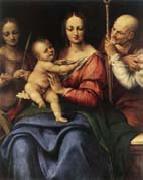 |
Cesare da Sesto
|
|
Italian High Renaissance Painter, 1477-1523, He was an Italian painter of the Renaissance active in Milan and elsewhere in Italy. He was born in Sesto Calende, Lombardy. He is considered one of the Leonardeschi or artists influenced by Leonardo da Vinci, such as Bernardino Luini and Marco D'Oggione. He may have trained or worked with Baldassare Peruzzi in Rome in 1505. Of this period, a lunette in Sant'Onofrio and some paintings in Campagnano Romano are attributed to him. From 1514 he soujourned in Naples for six years. In 1515 he finished a monumental polyptych for the Abbey of Santissima Trinita at Cava de' Tirreni. Back in Milan, he executed a Baptism of Christ, in collaboration with Bernardino Bernazzano (now lost) and a Salome, acquired by Rudolf II and now at the Kunsthistorisches Museum of Vienna. |
|
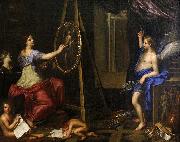 |
Charles Alphonse du Fresnoy
|
|
(1611C1665), French painter and writer on his art, was born in Paris, son of an apothecary.
He was destined for the medical profession, and well educated in Latin and Greek; but, having a natural propensity for the fine arts, he would not apply to his intended vocation, and was allowed to learn the rudiments of design under Perrier and Vouet. At the age of twenty-one he went off to Rome, with no resources; he drew ruins and architectural subjects.
After two years thus spent he re-encountered his old fellow-student Pierre Mignard, and by his aid obtained some amelioration of his professional prospects. He studied Raphael and the antique, went in 1633 to Venice, and in 1656 returned to France. During two years he was now employed in painting altar-pieces in the château du Raincy, landscapes, etc. His death was caused by an attack of apoplexy followed by palsy; he expired at Villiers-le-Bel, near Paris. He never married.
His pictorial works are few; they are correct in drawing, with something of the Caracci in design, and of Titian in colouring, but wanting fire and expression, and insufficient to keep his name in any eminent repute.
He is remembered now almost entirely as a writer rather than painter. His Latin poem, De arte graphica, was written during his Italian sojourn, and embodied his observations on the art of painting; it may be termed a critical treatise on the practice of the art, with general advice to students. The precepts are sound according to the standard of his time; the poetical merits slender enough. The Latin style is formed chiefly on Lucretius and Horace. |
|
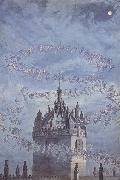 |
Charles Altamont Doyle
|
|
1832-1893
was a Victorian artist. He was the brother of the artist Richard Doyle, and the son of the artist John Doyle. Although the family was Irish, Doyle was born and raised in England. In 1849 he moved to Edinburgh where he met Mary Foley. They were married on 31 July 1855. Their children included Arthur Conan Doyle, creator of Sherlock Holmes, John Francis Innes Hay Doyle (known as Innes or Duff), and Jane Adelaide Rose Foley n??e Doyle (known as Ida). Doyle was not as successful an artist as he wished, and suffered depression and alcoholism. His paintings, which were generally of fairies, such as "A Dance Around The Moon", or similar fantasy scenes, reflected this, becoming more macabre over time. In 1881 Doyle was committed to a nursing home specialising in alcoholism. While there, his depression grew worse, and he began suffering epileptic seizures. Following a violent escape attempt he was sent to Sunnyside, Montrose Royal Lunatic Asylum, where he continued to paint. He died in Crighton Royal Institution in 1893. |
|
|
|
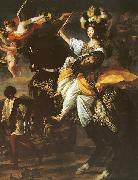 |
Charles Dauphin
|
|
Charles Claude Dauphin or Dofin, called in Italian Delfino, a French painter of historical subjects and portraits, was the son of Olivier Dauphin. He went to Turin about the year 1664, and worked there for the Prince of Carignano. He was also employed for the churches, but his works are in no great estimation, abounding as they do with the most ridiculous absurdities. In the church of San Carlo is an altar-piece by him, described by Lanzi as a most ludicrous composition. He died in 1677. |
|
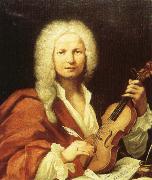 |
charles de brosses
|
|
(1709-77). President of the Parlement de Dijon, friend of the philosophes, and in Diderot's words ??une petite t??te gaie, ironique et satiriquee. His learned publications include important work on the origins of language (Traite de la formation m??canique des langues, 1765) and on primitive religion (Du culte des dieux fetiches, 1760). His Lettres familieres crites d Italie en 1739 et 1740, published posthumously in 1799 and much loved by Stendhal, offer a model of personal travel writing, in which detailed accounts of art works and monuments, not always complimentary, or a careful description of Vesuvius, addressed to Buffon, are interspersed with sprightly, enthusiastic accounts of the peculiarities and the aesthetic and sensual pleasures of life in Italy.
|
|
|
|
 |
Charles de La Fosse
|
|
(June 16, 1636 - December 13, 1716), French painter, was born in Paris.
He was one of the most noted and least servile pupils of Le Brun, under whose direction he shared in the chief of the great decorative works undertaken in the reign of Louis XIV. Leaving France in 1662, he spent two years in Rome and three in Venice. The influence of his prolonged studies of Veronese is evident in his "Finding of Moses" (Louvre), an in his "Rape of Proserpine" (Louvre), which he presented to the Royal Academy as his diploma picture in 1673. He was at once named assistant professor, and in 1674 the full responsibilities of the office devolved on him, but his engagements did not prevent his accepting in 1689 the invitation of Lord Montagu to decorate Montagu House.
He visited London twice, remaining on the second occasionetogether with Rousseau and Monnoyer more than two years. William III vainly strove to detain him in England by the proposal that he should decorate Hampton Court, for Le Brun was dead, and Mansart pressed La Fosse to return to Paris to take in hand the cupola of Les Invalides. The decorations of Montagu House are destroyed, those of Versailles are restored, and the dome of the Invalides (engraved, Picart and Cochin) is now the only work existing which gives a full measure of his talent. During his latter years La Fosse executed many other important decorations in public buildings and private houses, notably in that of Crozat, under whose roof he died on 13 December 1716.
This article incorporates text from a publication now in the public domain: Chisholm, Hugh, ed (1911). Encyclopædia Britannica (11th ed.). Cambridge University Press.
|
|
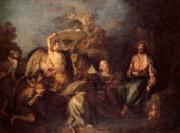 |
Charles de Lafosse
|
|
French Baroque Era Painter ,
Paris 1636/40 -1716
French painter and draughtsman. He was the most important decorative painter in France in the generation after Charles Le Brun and in this capacity contributed to many of the major official and private building projects from the 1670s to the 1710s, including the D?me des Invalides in Paris and the chapel at the ch?teau of Versailles. His colourist's temperament, his early study of the Venetian painters of the 16th century and his interest in the work of Peter Paul Rubens contributed to the triumph of the party that championed colour over line and put him in the vanguard of the new tendency in French painting in the later 17th century. His work, with its rich and changing colours, combines the strength of the 17th century with the lightness and grace of the 18th |
|
 |
Charles Deas
|
|
1818-1867,American painter. After an unsuccessful attempt to obtain an appointment at West Point Military Academy, he turned to an artistic career. He quickly earned recognition at the annual exhibitions of the National Academy of Design, New York, to which he was elected an associate member in 1839, with subjects taken from James Fenimore Cooper, such as the Turkey Shoot (c. 1837; Richmond, VA Mus. F.A.), and from Washington Irving, The Devil and Tom Walker (1838; Richard P. W. Williams priv. col.). |
|
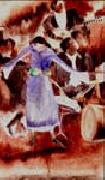 |
Charles Demuth
|
|
(November 8, 1883 - October 23, 1935) was an American watercolorist who turned to oils late in his career, developing a style of painting known as Precisionism.
"Search the history of American art," wrote Ken Johnson in the New York Times, "and you will discover few watercolors more beautiful than those of Charles Demuth. Combining exacting botanical observation and loosely Cubist abstraction, his watercolors of flowers, fruit and vegetables have a magical liveliness and an almost shocking sensuousness."
Demuth was a lifelong resident of Lancaster, Pennsylvania. The home he shared with his mother is now a museum of his work. He graduated from Franklin & Marshall Academy before studying at Drexel University and at Philadelphia's Pennsylvania Academy of Fine Arts. |
|
|

